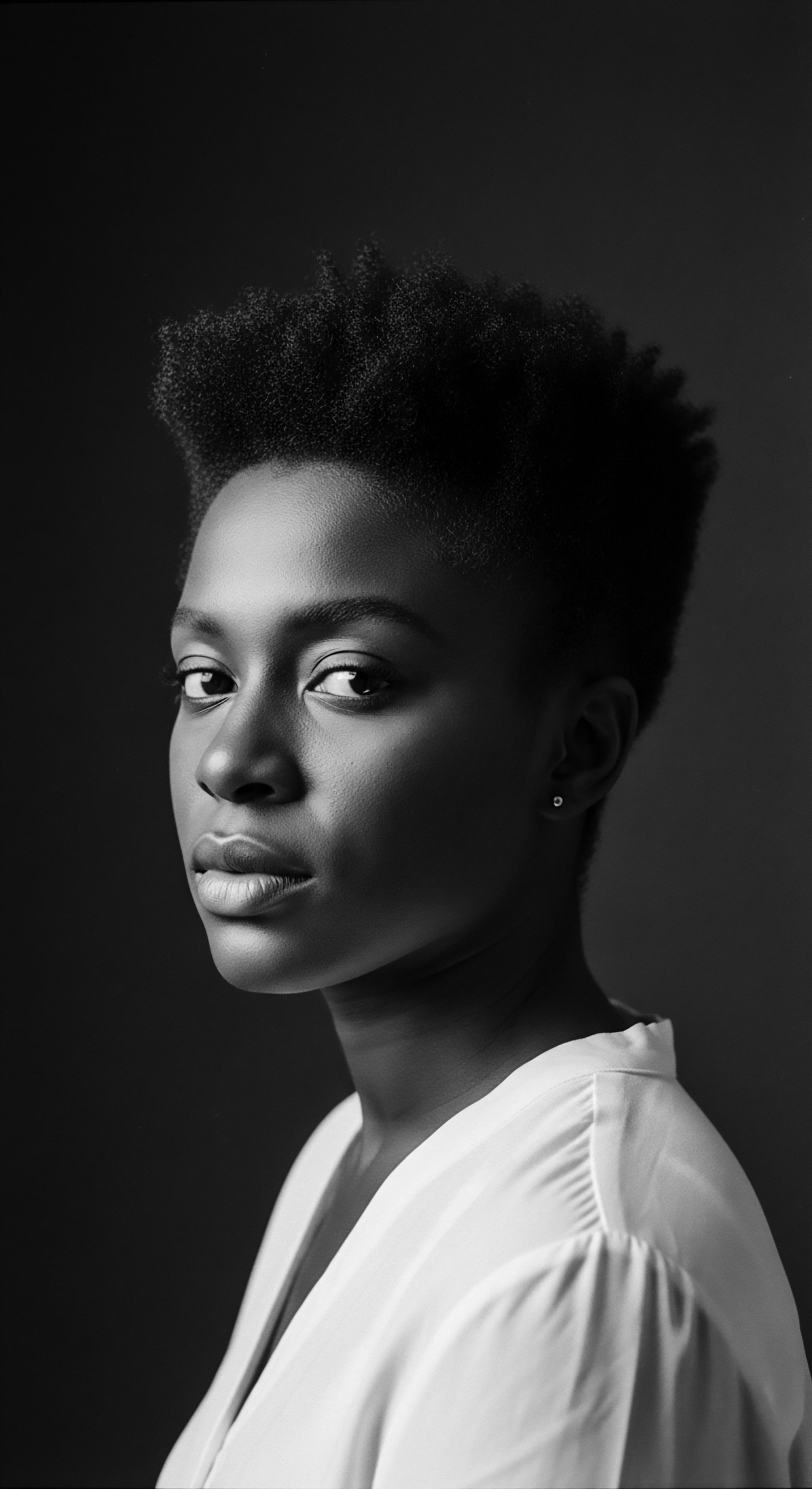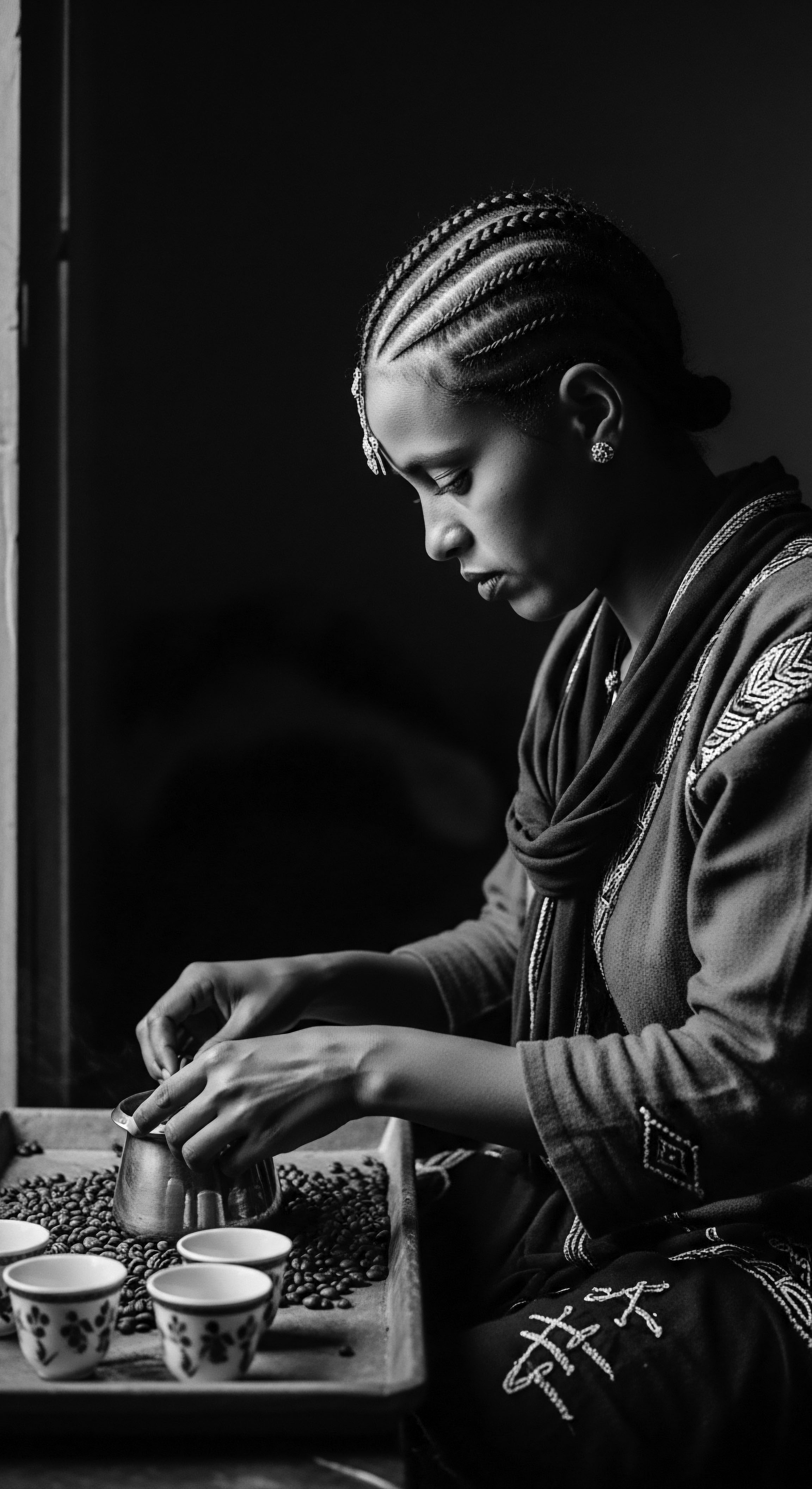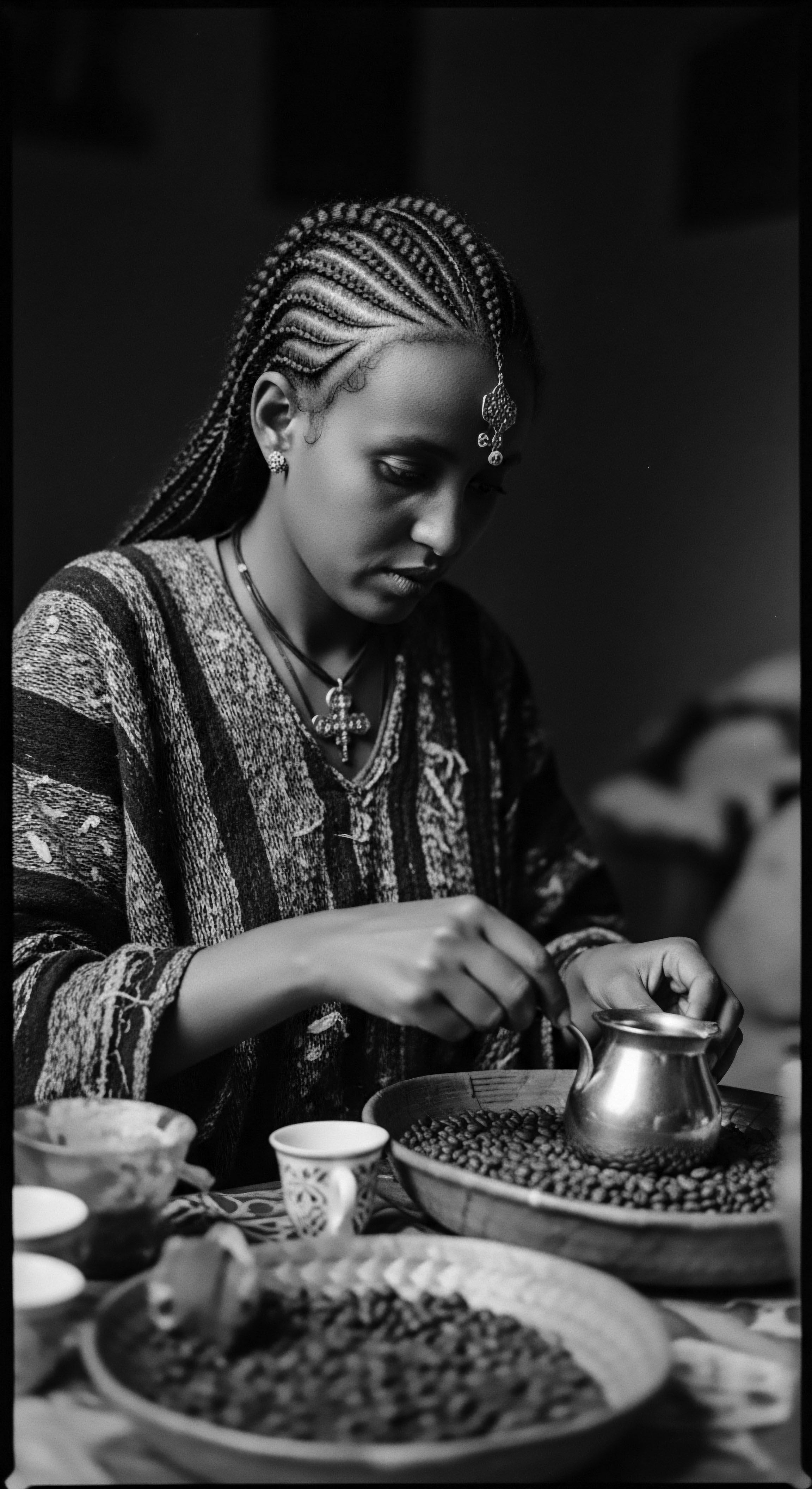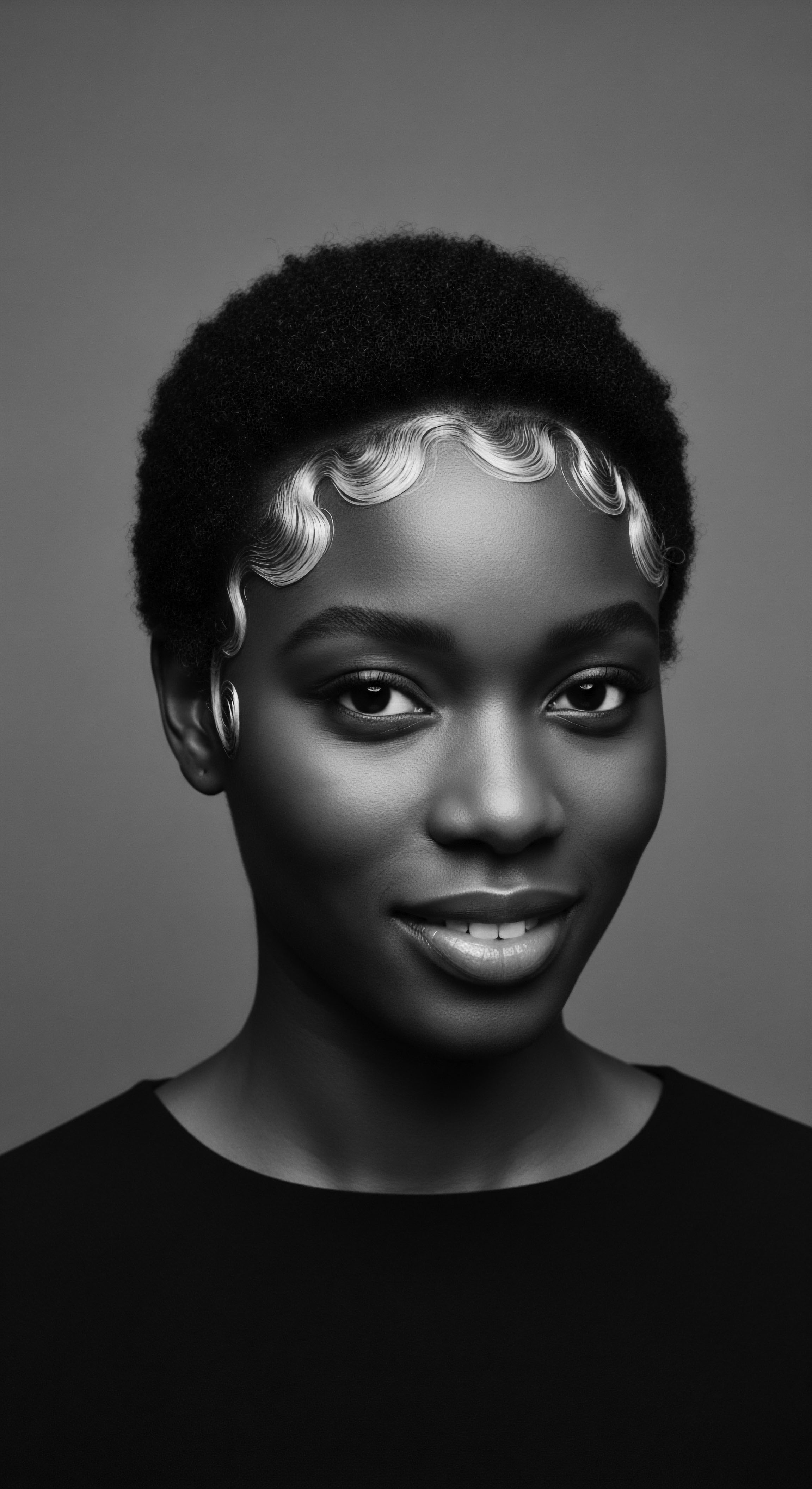
Fundamentals
The term Cocoa Butter refers to the pale-yellow, edible vegetable fat extracted from the cacao bean, the seed of the Theobroma cacao L. plant. This botanical designation, meaning “food of the gods,” speaks to the profound reverence ancient civilizations held for this resource. Its fundamental explanation lies in its composition ❉ a solid fat at room temperature, it melts readily upon contact with the warmth of human skin, a characteristic that makes it uniquely suited for topical application.
The process of its creation typically involves fermenting, drying, roasting, and then pressing the cacao beans to separate the rich fat from the cocoa solids. This creamy substance, with its mild, often chocolate-like aroma, has transcended its culinary origins to become a cherished ingredient in personal care formulations across generations and geographies.
The designation of Cocoa Butter as a foundational element in hair and skin care, particularly within textured hair traditions, stems from its intrinsic qualities. Its primary meaning in this context centers on its capacity to moisturize and protect. For individuals seeking to understand its basic purpose, Cocoa Butter provides a physical barrier, sealing in moisture and contributing to the softness and pliability of strands. This simple, yet powerful, function forms the bedrock of its enduring presence in routines designed to honor and preserve the integrity of diverse hair patterns.
Cocoa Butter, derived from the revered cacao bean, stands as a timeless emollient, offering deep moisture and protection, particularly for textured hair, echoing ancient wisdom in modern care.

Echoes from the Source ❉ The Cacao Tree and Its Gifts
The story of Cocoa Butter begins with the Cacao Tree, a tropical evergreen native to Mesoamerica, with its roots stretching back over 3,000 years. Ancient civilizations, including the Olmec, Mayan, and Aztec, held the cacao bean in high esteem, recognizing its spiritual and practical value. They utilized cacao not only for ceremonial beverages but also for its nourishing properties on the body. This deep connection to the land and its botanical offerings forms the ancestral blueprint for understanding Cocoa Butter’s role in human wellness.
- Theobroma Cacao L. ❉ This scientific name, translating to “food of the gods,” underscores the historical reverence for the cacao plant across indigenous cultures.
- Ancient Mesoamerican Use ❉ Early peoples applied cacao butter for its medicinal qualities and to enhance skin beauty, a practice that laid the groundwork for its later use in hair care.
- Nutrient Profile ❉ Cacao beans possess nutritive fatty acids, minerals, polyphenols, and Vitamin E, components that translate into the beneficial properties of the extracted butter.

Initial Applications and Cultural Significance
The earliest documented applications of Cocoa Butter, or raw cacao butter, were deeply intertwined with daily life and spiritual practices. Beyond its use as currency in some ancient societies, its primary purpose as a topical agent was to soothe and protect skin exposed to harsh elements. This foundational understanding of its protective qualities extended naturally to hair, particularly for those with textured strands that often require additional care to retain moisture and resist environmental stressors. The delineation of Cocoa Butter’s utility in these early contexts provides a clear picture of its inherent value, long before modern scientific inquiry.
| Traditional Application (Historical Context) Protection against sun and wind for scalp and hair |
| Modern Application (Contemporary Context) UV protection and environmental barrier for strands |
| Traditional Application (Historical Context) Moisturizing and softening hair to prevent breakage |
| Modern Application (Contemporary Context) Deep conditioning, frizz reduction, and elasticity enhancement |
| Traditional Application (Historical Context) Used in hair pomades and mixtures for ancestral styling |
| Modern Application (Contemporary Context) Ingredient in shampoos, conditioners, and styling creams |
| Traditional Application (Historical Context) The continuity of Cocoa Butter's utility, from ancient protective balms to contemporary conditioning agents, reflects its timeless suitability for textured hair. |

Intermediate
The intermediate meaning of Cocoa Butter extends beyond its simple designation as a fat from the cacao bean; it embodies a historical continuum of care for textured hair, deeply rooted in ancestral practices and the collective wisdom of Black and mixed-race communities. This understanding involves recognizing its profound significance as a medium for moisture retention, scalp health, and the structural integrity of curls, coils, and waves. The interpretation of Cocoa Butter’s value shifts from a mere ingredient to a cherished tool within a heritage of self-care and communal bonding. Its elucidation reveals a substance that not only lubricates and softens but also serves as a cultural touchstone, passed down through generations.
A deeper look into the designation of Cocoa Butter within textured hair care uncovers its role in mitigating challenges historically faced by these hair types, such as dryness, breakage, and environmental damage. The substance provides a robust, protective layer, a function particularly vital for hair that naturally experiences greater moisture loss due to its structural characteristics. The import of Cocoa Butter within these contexts is not merely cosmetic; it represents a tangible link to resilience, adaptation, and the ingenuity of ancestors who harnessed nature’s gifts for wellbeing.
Cocoa Butter’s deeper meaning for textured hair lies in its historical capacity to lock in moisture, protect delicate strands, and affirm a legacy of natural care.

The Tender Thread ❉ Living Traditions of Care and Community
The application of Cocoa Butter in textured hair traditions often speaks to a tender, communal approach to care, where knowledge and practices were shared within families and communities. In many West African societies, where cacao cultivation is prevalent, ingredients like Cocoa Butter were integral to daily routines, reflecting a holistic view of beauty intertwined with wellness. This collective knowledge, often transmitted orally, formed a living library of hair wisdom, emphasizing the importance of hydration and protection for diverse hair patterns.

Ancestral Practices and Diasporic Adaptation
Across the African continent, and subsequently within the diaspora, the use of natural butters and oils was a common thread in hair care. While Shea Butter is widely recognized, Cocoa Butter also held its place, particularly in regions where cacao was indigenous or became a significant crop. These practices were not static; they adapted as communities navigated new environments and challenges. For instance, in the Caribbean and later among Black communities in colder climates like the UK, Cocoa Butter became a household staple, employed to combat the drying effects of hard water and harsh weather on textured hair and skin.
A specific historical example illustrating this adaptation can be found in the experiences of the Windrush generation and their descendants in the United Kingdom. As noted by Keeks Reid in Cosmopolitan, families migrating from the Caribbean to Britain in the mid-20th century encountered a dramatically different climate and water quality. The hard water and cold, brisk winds of the UK often caused dryness in textured hair, leading to a reliance on deeply moisturizing agents. Reid describes how her grandparents, having emigrated from Jamaica, taught her mother to “baste” their bodies in Cocoa Butter because their skin was dry from the cold, and their scalps with other emollients for the same reason.
This narrative provides a poignant case study of how ancestral knowledge of natural ingredients like Cocoa Butter was reapplied and intensified to meet the specific environmental demands of a new homeland, thereby reinforcing its cultural significance within the diaspora. This demonstrates how a familiar ingredient became a shield against environmental aggressors, solidifying its role in diasporic hair care rituals.

Rituals of Nourishment and Connection
The application of Cocoa Butter was often part of elaborate rituals, not merely a quick product application. These rituals often involved:
- Scalp Massages ❉ Massaging the scalp with warmed Cocoa Butter promoted blood circulation and delivered nutrients directly to hair follicles, encouraging healthy growth.
- Hair Masks and Pomades ❉ Cocoa Butter was incorporated into homemade hair masks or pomades, providing deep conditioning and a protective coating for strands. These concoctions often blended Cocoa Butter with other regional oils or herbs, tailoring the care to specific hair needs and available resources.
- Protective Styling Support ❉ When hair was braided or twisted, Cocoa Butter was used to moisturize the hair and scalp underneath these styles, minimizing breakage and maintaining the integrity of the hair during periods of extended styling. This approach speaks to a proactive understanding of hair health and longevity.
The substance was more than a mere emollient; it became a symbol of care, continuity, and cultural identity. The gentle act of applying butter, often by a mother or elder, created moments of connection, passing down not only a practice but also a sense of self-worth tied to one’s heritage.

Academic
The academic delineation of Cocoa Butter transcends common understanding, presenting it as a complex lipoidal matrix with profound implications for the biophysical properties of textured hair and the socio-cultural dynamics of its historical use. Its meaning, from a rigorous scientific and anthropological perspective, encompasses its unique fatty acid profile, its occlusive and emollient characteristics, and its documented role in traditional medicine and cosmetic practices across diverse human populations. The elucidation of Cocoa Butter’s efficacy within the context of textured hair care requires an examination of its molecular structure and how this structure interacts with the distinct architecture of Black and mixed-race hair strands, along with a critical analysis of its historical and contemporary cultural significance. This rigorous approach seeks to provide a comprehensive interpretation, grounded in both empirical observation and cultural scholarship.
The designation of Cocoa Butter as a beneficial agent for textured hair is not merely anecdotal; it is substantiated by its high content of saturated fatty acids, primarily stearic and palmitic acids, alongside oleic acid. These lipids form a protective barrier on the hair shaft, reducing transepidermal water loss from the scalp and preventing moisture evaporation from the hair strand itself. For hair types prone to dryness and breakage due to their helical structure and fewer cuticle layers, this occlusive property is particularly significant, providing a mechanism for moisture retention that has been instinctively understood and utilized by ancestral communities for centuries. The specification of its chemical composition directly informs its functional utility, offering a scientific underpinning to long-held traditional practices.
Cocoa Butter, academically defined, represents a lipid-rich botanical asset, scientifically validated for its occlusive properties crucial to the moisture retention and structural resilience of textured hair, a knowledge deeply embedded in ancestral wisdom.

Biophysical Interaction with Textured Hair
The unique architecture of textured hair, characterized by its varying curl patterns—from waves to tight coils—presents distinct challenges related to moisture distribution and susceptibility to breakage. The natural oils produced by the scalp, sebum, struggle to travel down the curved and often elliptical hair shaft, leaving the ends particularly vulnerable to dryness. Herein lies the profound significance of Cocoa Butter. Its solid yet meltable consistency allows it to coat the hair shaft effectively, creating a hydrophobic layer that seals in moisture.

Lipid Profile and Hair Health
The specific lipid profile of Cocoa Butter, rich in saturated fats, offers stability and a high melting point, making it an ideal sealant.
- Stearic Acid ❉ This saturated fatty acid contributes to the butter’s solid structure and its ability to form a protective film on the hair, guarding against environmental aggressors.
- Palmitic Acid ❉ Another saturated fatty acid, palmitic acid, reinforces the occlusive barrier, preventing moisture loss and enhancing the hair’s suppleness.
- Oleic Acid ❉ While primarily saturated, Cocoa Butter also contains oleic acid, a monounsaturated fatty acid that provides additional conditioning and can penetrate the hair shaft to a certain degree, offering internal nourishment.
The collective action of these fatty acids contributes to improved hair elasticity, reduced frizz, and an enhanced natural sheen, properties that have been observed and valued in traditional hair care for generations.

Antioxidant and Phytochemical Contributions
Beyond its lipid content, Cocoa Butter contains antioxidants, including polyphenols and flavonoids, alongside vitamins E and K. These bioactive compounds provide protective benefits against environmental stressors and oxidative damage. Oxidative stress can compromise hair follicle health and contribute to hair degradation, particularly in hair types that may be more susceptible to external damage due to their structure. The presence of these antioxidants in Cocoa Butter, therefore, offers a biochemical explanation for its traditional use in promoting overall hair and scalp vitality.
Research into the waste skin of cocoa fruit, for instance, has even indicated its potential efficacy in stimulating hair growth and addressing alopecia, suggesting a deeper therapeutic application beyond mere moisturization. This area of study continues to broaden the academic understanding of cacao’s comprehensive benefits for hair.

The Unbound Helix ❉ Voicing Identity and Shaping Futures
The role of Cocoa Butter in textured hair care extends beyond its physical properties, becoming a symbol within the broader discourse of Black and mixed-race identity and self-acceptance. The very act of choosing natural ingredients, often rooted in ancestral practices, is a powerful statement of heritage and cultural pride. The historical trajectory of textured hair, from being a marker of identity in pre-colonial Africa to facing systemic oppression and denigration during slavery and beyond, underscores the significance of products that affirm its inherent beauty.

A Legacy of Resilience and Resistance
During periods of enslavement, traditional hair care practices, including the use of natural butters, were often suppressed or adapted under harsh conditions. Yet, the knowledge of ingredients like Cocoa Butter persisted, often secretly, becoming a quiet act of resistance and a means of maintaining connection to a lost heritage. This substance, once a tool for protection and adornment in ancestral lands, became a silent testament to the enduring spirit of a people determined to preserve their cultural essence. The continuous thread of care, passed down through generations, became a subtle yet profound act of defiance against narratives that sought to diminish the beauty and worth of textured hair.
The contemporary resurgence of natural hair movements globally further elevates the meaning of Cocoa Butter. It represents a conscious return to practices that honor the hair’s natural state, moving away from Eurocentric beauty standards that historically promoted chemical alteration. The use of Cocoa Butter in this context is not merely about hair health; it is about reclaiming identity, celebrating ancestral wisdom, and shaping a future where all hair textures are recognized and revered.
Afro shops in diasporic communities, for instance, serve as cultural hubs where ingredients like Cocoa Butter are readily available, symbolizing a connection to home and heritage. These spaces become sites of affirmation, where the cultural and practical significance of such ingredients is understood and celebrated.

Economic and Ethical Considerations
The global demand for Cocoa Butter also brings into focus important ethical and economic considerations, particularly concerning its sourcing from West Africa, which accounts for nearly 70% of global cacao production. A critical examination of its supply chain reveals a history intertwined with exploitative labor practices, a legacy of colonialism that continues to affect cacao farming communities. Therefore, the conscious choice of ethically sourced Cocoa Butter aligns with Roothea’s ethos of holistic wellness, which extends to the wellbeing of the communities and ecosystems from which these precious ingredients originate. This responsible engagement with the product’s provenance adds another layer to its academic and cultural meaning, moving beyond individual hair care to collective responsibility and systemic justice.
The deeper meaning of Cocoa Butter, therefore, is not solely encapsulated in its chemical composition or its functional properties for hair. It is inextricably linked to a complex history of human migration, cultural adaptation, resilience, and the ongoing quest for self-determination and recognition within Black and mixed-race communities. Its presence in a “living library” signifies a dynamic, evolving understanding—one that respects ancient wisdom, acknowledges historical struggles, and envisions a future where textured hair is universally celebrated in its natural glory.

Reflection on the Heritage of Cocoa Butter
As we close this contemplation on Cocoa Butter, its enduring significance within Roothea’s living library resonates deeply with the very Soul of a Strand. This humble butter, born from the sacred cacao tree, represents far more than a simple cosmetic ingredient; it is a profound testament to the ancestral ingenuity and resilience embedded within textured hair heritage. Its journey, from the ceremonial grounds of Mesoamerica to the vibrant diasporic communities across the globe, mirrors the journey of Black and mixed-race hair itself—a path marked by adaptation, preservation, and persistent beauty.
The whispered wisdom of generations, carried through the careful application of emollients to protect and nourish, finds a harmonious echo in the scientific validation of Cocoa Butter’s occlusive properties. This convergence of traditional knowledge and modern understanding allows us to appreciate the unbroken lineage of care that has sustained textured hair through centuries of change. It reminds us that every strand holds a story, a memory of hands that once applied these natural gifts, ensuring moisture and strength against the elements.
The selection of Cocoa Butter in hair care, particularly within communities that have faced historical pressures to conform, speaks to a powerful reclamation of identity. It symbolizes a conscious choice to honor the inherent beauty of coils, curls, and waves, rejecting narratives that once deemed them less worthy. This is not merely about product preference; it is an act of cultural affirmation, a gentle yet firm declaration of self-love that extends from the crown to the deepest roots of one’s heritage.
In reflecting upon Cocoa Butter, we are invited to consider our own connection to this ancestral thread. What stories does our hair hold? How do our choices in care honor the wisdom passed down through time?
The butter becomes a conduit, a tangible link to a rich past, inspiring a future where textured hair is not just cared for, but revered as a vibrant, living archive of human experience and enduring spirit. Its gentle aroma carries the whispers of ancient forests and the strength of a legacy that continues to flourish, unbound and beautiful.

References
- Reid, K. (2023, July 25). Real talk, has the Diaspora messed up your U.K. beauty routine? Cosmopolitan.
- Praan Naturals. (n.d.). Ethically Sourced Ingredients – Praan Naturals.
- Beautifying Benefits of Natural Cocoa Butter. (2017, December 6). Natural Oils and Butters.
- Axe, J. (2023, October 30). 9 Cocoa Butter Benefits and Uses for Dry Skin and More – Dr. Axe. Dr. Axe.
- Natural Poland. (2023, July 21). Cacao in Africa ❉ Cocoa Butter as a Source of Health and Beauty – NATURAL POLAND.
- Africa Imports. (2024, June 25). Cocoa and Shea Butters ❉ African Beauty Secret for Hair Care and Glowing Skin.
- Quora. (2017, June 22). How did black people do their hair in Africa before slavery began?
- The Funambulist Magazine. (2020, April 29). What Afro Shops Mean for the African Diaspora in Berlin – THE FUNAMBULIST MAGAZINE.
- Missouri Botanical Garden. (2018, March 28). Plant Profile ❉ Cacao – Discover + Share.
- Seek Bamboo. (n.d.). Shea Butter Vs Cocoa Butter | Difference Between Shea and Cocoa Butter – Seek Bamboo.
- Ecosystem Laboratoire. (2024, July 26). The benefits of natural butters ❉ shea, cocoa! – Ecosystem Laboratoire.
- Southwest Shadow. (2018, August 30). Cocoa butter with cornrows – Southwest Shadow.
- Spreading Clean Beauty. (n.d.). Cacao extract ❉ benefits for skin and hair – Spreading Clean Beauty.
- Assendelft. (n.d.). The Benefits of African Cocoa Butter for Skin Care | Assendelft.
- Hall, A. L. & Callender, V. D. (2025, March 4). Historical Perspectives on Hair Care and Common Styling Practices in Black Women.
- Priani, S. E. Eka, S. & Lestari, S. (2022, March 14). New Hair Growth Cream Formulation with Cocoa Pod Peel (Theobroma cacao L.). ResearchGate.
- Priani, S. E. Eka, S. & Lestari, S. (2022, March 14). New Hair Growth Cream Formulation with Cocoa Pod Peel (Theobroma cacao L.). PMC.
- BLAM UK CIC. (2022, September 15). The history of Black Hair – BLAM UK CIC.
- SpecialChem. (n.d.). Theobroma Cacao Seed Butter – Cosmetics Ingredients – SpecialChem.
- Anti-Slavery International. (n.d.). The Cocoa Industry in West Africa ❉ A history of exploitation – Anti-Slavery International.
- Cadiveu Professional. (n.d.). Cocoa butter with cornrows – Southwest Shadow.
- Tattvalogy. (2023, July 28). From Ancient Wisdom to Modern Skincare ❉ The Power of Cocoa Butter.
- Baume des Dieux. (n.d.). How Cocoa Butter Can Help Your Hair ❉ The Benefits of This Natural Skin Care Product.
